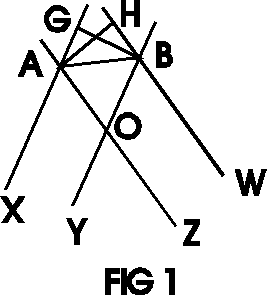Geometrical Exploits
Lemma 1.Given two pairs of parallel lines - (XA,YB) and (ZA,WB), see FIG 1. Assume that distances between the lines in the two pairs are equal, i.e., dist(XA, YB) = dist(ZA, WB). Then
1. ∠XAB = ∠ABW Proof:Let us drop perpendiculars from A and B onto WB and XA, respectively. Two right triangles ABH and ABG are equal. Indeed, they share a hypotenuse AB and AH = BG by the conditions of the Lemma. Therefore, ∠GAB = ∠HBA. However, ∠XAB = 180 - ∠GAB and ∠ABW = 180 - ∠HBA. Which proves 1.Further, ∠XAZ = ∠YBW since their sides are parallel. Subtracting this from 1 we get ∠OAB = ∠OBA so that the triangle OAB is isosceles. This proves 2. Now referring to FIG 2. we have the following Corollary 1.
1. ∠EAB = ∠ABC = ∠BCD. Corollary 2.EA = AB = BC = CD. Indeed, each of the above segments serves as a hypotenuse of a right triangle built in the manner of ABH and ABG on FIG 1. Corollary 3.AD = BE.
Indeed, by Lemma 1.2 AD = BD and BD = BE.
Lemma 2.Two quadrilaterals ABCD and BCDE are equal. Proof:Both quadrilaterals are trapeze. We sum up equality of their corresponding elements in the following table:
Q.E.D.Corollary 4.
1. CD = DE. Now combining Corollaries 1, 2 and 4 we obtain, as promised, the following Theorem.ABCDE on FIG 2 is a regular pentagon. |Contact| |Front page| |Contents| |Geometry| |My Logo| Copyright © 1996-2018 Alexander Bogomolny 73533350 |


